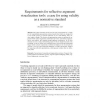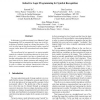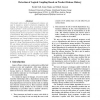114 search results - page 6 / 23 » Mind Change Complexity of Learning Logic Programs |
COMMA
2008
13 years 10 months ago
2008
This paper formulates in the first part some requirements for a certain sort of computational argumentation systems, namely those which are designed for a very specific purpose: to...
CORR
2010
Springer
13 years 6 months ago
2010
Springer
The paradigm of Tabled Logic Programming (TLP) is now supported by a number of Prolog systems, including XSB, YAP Prolog, B-Prolog, Mercury, ALS, and Ciao. The reasons for this ar...
ICDAR
2009
IEEE
14 years 3 months ago
2009
IEEE
In this paper, we make an attempt to use Inductive Logic Programming (ILP) to automatically learn non trivial descriptions of symbols, based on a formal description. This work is ...
ICSM
1998
IEEE
14 years 29 days ago
1998
IEEE
Code-based metrics such as coupling and cohesion are used to measure a system's structural complexity. But dealing with large systems--those consisting of several millions of...
ML
2006
ACM
13 years 8 months ago
2006
ACM
In this paper, we describe the syntax and semantics for a probabilistic relational language (PRL). PRL is a recasting of recent work in Probabilistic Relational Models (PRMs) into ...



